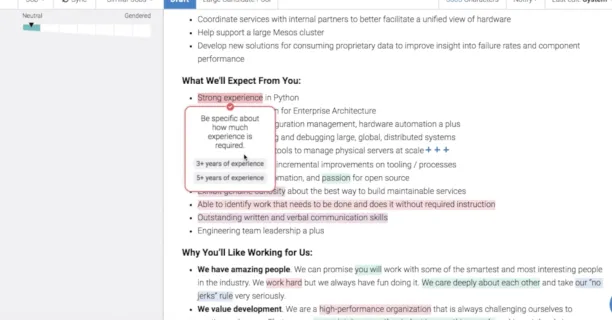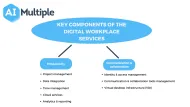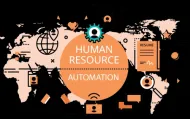10 HR Digital Transformation Applications/Use Cases in 2024
Digital transformation is one of those buzzwords every executive frequently encounters. Though digital transformation is mostly recognized as replacing the existing technology stack of businesses with digital solutions, it is also about people in your business and how they adapt and work together to support organizational goals. The HR department has a role to support an organization’s most valuable resource, people, to succeed in a digital world.
We always talk about technology but HR’s role in digital transformation is two-fold. It both needs to digitally transform its processes and also support the overall digital transformation of the organization. Though these may seem like two different projects, they are intertwined. The faster HR transforms itself, the more it can serve as an example to the whole business.
What is digital transformation in HR?
In short, digital transformation is implementing digital technologies to business functions to improve organizations’ productivity while enhancing customer experience. Digital transformation is changing the way HR offices work from the way they hire and develop talent, to productivity improvements that come with automation.
Why is digital transformation important in HR processes?
According to PwC’s Human Resources Technology Survey, the top concerns of HR teams are
- Attracting top talent and keeping them due to increasing competition
- Developing everyone to reach their potential
- Improving employee experience, primarily by automating tasks
Digital HR addresses these concerns partially with digital HR solutions. However, these tools need to be complemented with the right processes and initiatives by the HR team. Though we are excited about technology, it is only one of the ingredients of a company’s culture.
After the COVID-19 pandemic, digital transformation became even more crucial for the HR office since pandemic made businesses shift toward remote working practices, and building a collaborative remote working environment is the role of HR.
What are HR digital transformation use cases?
Lead search & identification
Searching for, and identifying, suitable candidates for a job position is a process that could be automated. The benefit is that the software will take care of scraping the data en masse and rather quickly. Then based on predetermined rules, candidates that meet the given criteria will automatically be sent an email for further inquiries.
For recruitment processes
Recruitment automation: RPA & Applicant tracking systems (ATS)
Applicant tracking systems (ATS) are widely used to minimize the time spent on unqualified candidates. Software screens candidate resumes and eliminates unqualified candidates’ resumes from the list automatically by using keyword filtering. However, with advancements in machine learning and AI, these systems can be trained based on accepted candidates’ success data. Along with resume screening, ATSs are capable of job posting, pre-interview testing, interview planning, and interview evaluation features.
For more information on applicant tracking systems, you can check out our comprehensive article.
AI-powered job post writers
We’ve talked about automated content generation before. HR professionals can use AI-powered job post writer tools to write better job postings. The image below is an illustration of how these tools improve job postings.

Onboarding software
From the moment the candidate signs an employment contract to the first day of the candidate, the HR professional deals with multiple manual tasks such as introduction to tools used, virtual office tours for orientation, and meeting the team. Onboarding tools are capable of personalizing onboarding journeys of new hires while automating manual tasks HR specialists are responsible for.
Recruiter chatbots
Recruiter chatbots are another AI-enabled HR trend that helps recruiters save recruiting time by screening and staging candidates throughout the hiring process. These bots engage with candidates and enhance the candidate experience.
For more information on how AI changes recruitment, we have an in-depth guide for you.
For improved productivity
HR Analytics
Analytics projects have been great leverage for organizations to improve their processes and services. Businesses can use workforce analytics to better assess workforce performance. Workforce analytics uses employee and enterprise data to gain insights about employee and HR performance by using metrics such as time to fill, cost per hire, competency analytics, retention rate, and replacement rate.
If you want to learn why your business needs HR analytics tools, here are 6 reasons to set up HR analytics.
HR chatbots
One of the tasks the HR team is responsible for is answering questions of employees. Employees mostly encounter the same challenges and ask the same questions to HR professionals. Deploying a chatbot that answers the FAQs of employees can save recruiters time. For example, Leena AI is a chatbot that helps HR teams automate employee queries, enhance employee experience and ensure employee engagement. It provides automatic replies for all employee queries that are documented in the enterprise knowledge base.
Talent management systems
After a successful hire, HR teams focus on the orientation of the new employee. Similarly, after an executive leaves the company, the promoted employee needs to be trained on the new responsibilities. A talent management system is integrated software that contains performance management, learning and development, compensation management, and succession planning components.
Performance management
Anyone with some corporate experience has been in performance review meetings with unclear feedback or next steps. Many companies struggle to align compensation with performance beyond executive or sales roles.
Performance management tools aim to assist HR teams in collecting feedback and building performance management systems that reward results.
Learning management
Continuous growth is the most necessary ingredient to success however even large companies manage their learning via hard-to-manage spreadsheets. Learning management software helps companies keep track of candidate development, identify the skills of employees, and experiment with new learning approaches.
Compensation management
Effective compensation management is crucial to employee happiness. For example, it would be demotivating to see that your bonus is incorrectly calculated in the HR systems. Compensation management systems keep track of all aspects of compensation including stock options etc. and facilitate this important process.
Attrition prediction
Employees do similar things before they leave a company. They improve their Linkedin profile, make connections to colleagues and connect with interviewers. It is valuable to know that employees intend to leave before they do so companies can plan their replacement and handover. There are cultural approaches to this problem such as mindful transition which advocates ending 15 days notice and encouraging employees to be open about their future career plans without the risk of retaliation from the employer.
Another approach is to predict which employees are going to leave soon using machine learning. So as usual, when humans fail, machines fill the gaps. HiQ Labs, a company that provides such technology, got embroiled in a long legal fight with Linkedin over the right to use publicly available Linkedin data as an input to their model.
Other
This is not a complete list. HR teams developing leading-edge solutions may want to work with custom AI model development companies to build machine learning models to address their specific challenges.
To further understand digital transformation trends and use cases post-COVID, we have also started a survey. If you want to support our research efforts and join our survey about post-COVID digital transformation trends, we would appreciate your participation and you will be the first to know about the results as soon as we publish them.
You can also read our article on HR technology trends.
What should HR do to support the company’s digital transformation?
What we have said so far was about digital transformation in the HR department. However, HR professionals are also an important enabler of organizational digital transformation. An innovative culture is essential for any digital transformation framework and its absence may cause digital transformation failures. Roles for HR in digital transformation are:
- Hiring digital talent that has digital capabilities such as design thinking, agility and a data-oriented mindset
- Creating an innovative and agile culture. Such a culture is required to pursue opportunities that arise due to changes in technology.
- Digital transformation is a long-term, strategic project requiring collaboration. HR needs to support it with the right communication initiatives and ensure organizational alignment.
- Working closely with business analysts to adopt a digital transformation enabler technology, such as process mining.
Further Reading
For more on digital transformation:
If you need guidance in your digital transformation journey, check our data-driven, sortable/filterable list of digital transformation consultant companies. If you still have questions about digital transformation in HR, we would like to help:

Cem has been the principal analyst at AIMultiple since 2017. AIMultiple informs hundreds of thousands of businesses (as per similarWeb) including 60% of Fortune 500 every month.
Cem's work has been cited by leading global publications including Business Insider, Forbes, Washington Post, global firms like Deloitte, HPE, NGOs like World Economic Forum and supranational organizations like European Commission. You can see more reputable companies and media that referenced AIMultiple.
Throughout his career, Cem served as a tech consultant, tech buyer and tech entrepreneur. He advised businesses on their enterprise software, automation, cloud, AI / ML and other technology related decisions at McKinsey & Company and Altman Solon for more than a decade. He also published a McKinsey report on digitalization.
He led technology strategy and procurement of a telco while reporting to the CEO. He has also led commercial growth of deep tech company Hypatos that reached a 7 digit annual recurring revenue and a 9 digit valuation from 0 within 2 years. Cem's work in Hypatos was covered by leading technology publications like TechCrunch and Business Insider.
Cem regularly speaks at international technology conferences. He graduated from Bogazici University as a computer engineer and holds an MBA from Columbia Business School.
To stay up-to-date on B2B tech & accelerate your enterprise:
Follow on

Comments
Your email address will not be published. All fields are required.